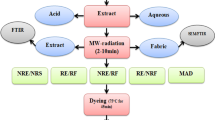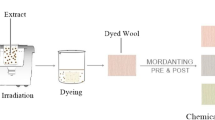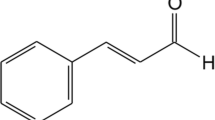Abstract
Environmental friendly products particularly natural dyes are going to be much popular around the globe due to their non-toxic and bio-degradable nature. The current study was planned to enhance the dyeability of walnut bark having juglone as a reddish-brown natural dye under ultrasonic radiation as an environment-friendly and green tool After conducting series of experiments, it has been found that wool (RW) and extract (RE) after ultrasonic treatment for 45 min, when dyed for 45 min at 55°C using an acidic bath of 3 pH has given good color strength on the wool fabric. To develop the new shades, sustainable and eco-label chemicals (Fe, Al, and tannic acid) and four bio-mordants such as Acacia bark, Turmeric, Henna, and Pomegranate were also applied at optimum conditions. It is studied that 3% of turmeric extract as pre-bio-mordant and 5% of Acacia extract as post-bio-mordant has given excellent color characteristics as compared to their synthetic. It is concluded that ultrasonic treatment being an eco-friendly tool has a great potential to improve the dyeability of natural reddish-brown dye from walnut bark and the inclusion of sustainable biosources as a color modifier has value-added the natural dyeing process with excellent color ratings.







Similar content being viewed by others
Data availability
The data is present and is available, as well as all dyed samples are also present.
References
Adeel S, Zuber M, Rehman FU, Zia KM (2018) Microwave-assisted extraction and dyeing of chemical and bio-mordanted cotton fabric using harmal seeds as a source of natural dye. Environ Sci Pollut Res 25(11):11100–11110
Adeel S, Rehman FU, Zia KM, Azeem M, Kiran S, Zuber M, Irfan M, Qayyum MA (2019) Microwave-supported green dyeing of mordanted wool fabric with arjun bark extracts. J Nat Fibers 18:1–15
Adeel S, Amin N, Rehman FU, Ahmad T, Batool F, Hassan A (2020a) Sustainable isolation of natural dyes from plant wastes for textiles. In: Recycling from waste in fashion and textiles: a sustainable and circular economic approach, vol 363
Adeel S, Habib H, Arif S, Rehman FU, Azeem M, Batool F, Amin N (2020b) Microwave-assisted eco-dyeing of bio mordanted silk fabric using cinnamon bark (CinnamomumVerum) based yellow natural dye. Sustain Chem Pharm 17:1–8
AbdEldaim MA, Abd El Latif AS, Hassan A, El-Borai NB (2020) Ginseng attenuates fipronil-induced hepatorenal toxicity via its antioxidant, anti-apoptotic, and anti-inflammatory activities in rats. Environ Sci Pollut Rese 27(36):45008–45017
Agnhage TA, Perwuelz N, Behary (2017) Towards sustainable Rubiatinctorum L. dyeing of woven fabric: how life cycle assessment can contribute. J Clean Prod 141:1221–1230
Ahmed N, Nassar S, M El-Shishtawy R (2020) Novel green coloration of cotton fabric. part I: bio-mordanting and dyeing characteristics of cotton fabrics with madder, alkanet, rhubarb and curcumin natural dyes. Egypt J Chem 63(5):1605–1617
Ahsan R, Masood A, Sherwani R, Khushbakhat H (2020) Extraction and application of natural dyes on natural fibers: an eco-friendly perspective. Rev Educ Admin law 3(1):63–75
Alcántara C, Žugčić T, Abdelkebir R, García-Pérez JV, Jambrak AR, Lorenzo JM, Collado C, Granato D, Barba FJ (2020) Effects of ultrasound-assisted extraction and solvent on the phenolic profile, bacterial growth, and anti-inflammatory/antioxidant activities of mediterranean olive and fig leaves extracts. Molecules 25(7):1718
Alebeid OK, Pei L, Sliman H, Zhou W, Wang J (2020) Study the dyeing behavior of wool fabric using henna extract in decamethylcyclopentasiloxane (D5) medium. J Text I 112:1–5
Ali MA, Nishkam A (2016) Extraction of dye from walnut shell and dyeing of natural fibre. IOSRJ Polym Text Eng 3(1):07–09
Amutha K, Annapoorani GS, Sudhapriya N (2020) Dyeing of textiles with natural dyes extracted from Terminaliaarjuna and Thespesiapopulnea fruits. Ind Crop Prod 148:112303
Atav R, Güneş E, Çifçi Dİ, Güneş Y (2020) Comparison of wool fabric dyeing with natural and synthetic dyes in view of ecology and treatability. AATCC J Res 7(6):15–22
dos Santos Silva PM, Fiaschitello TR, de Queiroz RS, Freeman HS, da Costa SA, Leo P, Antonio FM, da Costa SM (2020) Natural dye from croton urucuranabaill. bark: extraction, physicochemical characterization, textile dyeing and color fastness properties. Dyes Pigments 173:107953
Fierascu RC, Fierascu I, Ortan A, Georgiev MI, Sieniawska E (2020) Innovative approaches for recovery of phytoconstituents from medicinal/aromatic plants and biotechnological production. Molecules 25:309
Haji A, Ashraf S, Nasiriboroumand M, Lievens C (2020) Environmentally friendly surface treatment of wool fiber with plasma and chitosan for improved coloration with cochineal and safflower natural dyes. Fiber Polym 21:743–750
Haji A, Naebe M (2020) Cleaner dyeing of textiles using plasma treatment and natural dyes: A review. J Clean Prod 265:121866
Handayani PA, Chafidz A, Ramadani NS, Kartika D (2019) Microwave assisted extraction (MAE) process of tannin from mangrove propagules waste as natural dye for coloring Batik tulis. Key Eng Mater 805:128–133
Hosseinnezhad MK, Gharanjig R, Jafari H (2020) Imani, green dyeing of woolen yarns with weld and madder natural dyes in the presences of biomordant. Prog Color Color Coat 14:35–45
Hu WB, Yang ZW, Wang WJ (2019) Enzymolysis-ultrasonic assisted extraction of flavanoid from Cyclocaryapaliurus (Batal) Iljinskaja: HPLC profile, antimicrobial and antioxidant activity. Ind Crop Prod 130:615–626
Islam SU, Butola BS, Roy A (2018) Chitosan polysaccharide as a renewable functional agent to develop antibacterial, antioxidant activity and colorful shades on wool dyed with tea extract polyphenols. Int J Biol Macromol 120:1999–2006
İşmal ÖE (2017) Greener natural dyeing pathway using a by-product of olive oil; prina and bio-mordants. Fibers Polym 18:773–785
Jabar JM, Ogunmokun AI, Taleat TAA (2020) Color and fastness properties of mordanted Brideliaferruginea B dyed cellulosic fabric. Fash Text 7(1):2–13
Jiang H, Hu X, Meena B, Khan A, Hussain MT, Yao J, Wang J (2019) Extraction of natural dyes from the stem of Caulis spatholobi and their application on wool. Text Res J 89(23-24):5209–5217
Kamali Moghaddam M, GhanbariAdivi M, TehraniDehkordi M (2019) Effect of acids and different mordanting procedures on color characteristics of dyed wool fibers using eggplant peel (Solanummelongena L.). Prog Color Color Coat 12(4):219–230
Karolia A (2010). Walnut dye for wool and silk and development of a color palette for a product line. Textile Society of America Symposium Proceedings. 27.
Khan A, Islam SUM, Mohammad F (2016) Extraction of natural dye from walnut bark and its dyeing properties on wool yarn. J Nat Fibers 13(4):458–469
Khan SA, Khan MI, Yusuf M, Shahid M, Mohammad F, Khan MA (2011) Natural dye shades on woollen yarn dyed with Kamala (Mallotusphilippinensis) using eco-friendly metal mordants and their combination. Colourage 58(11):38–44
Khattab TA, Abdelrahman MS, Rehan M (2020) Textile dyeing industry: environmental impacts and remediation. Environ Sci Pollut Res Int 27(4):3803–8318
Kulkarni SS, Bodake UM, Pathade GR (2011) Extraction of natural dye from chili (Capsicum annum) for textile coloration. Univers J Environ Res Technol 1(1):58–63
Lei-Xiong, Lakka A, Grigorakis S, Kaltsa O, Karageorgou I, Batra G, Bozinou E, Makris DP (2020) The effect of ultrasonication pretreatment on the production of polyphenol-enriched extracts from Moringaoleifera L. (drumstick tree) using a novel bio-based deep eutectic solvent. Appl Sci 10(1):220
Ma X, Wei Y, Wang S, Zuo X, Shen B (2020) Sustainable ultrasound-assisted ultralow liquor ratio dyeing of cotton fabric with natural turmeric dye. Text Res J 90:685–694
Mathangadeera RW, Hequet EF, Kelly B, Dever JK, Kelly CM (2020) Importance of cotton fiber elongation in fiber processing. Ind Crop Prod 147:112217
Menegazzo MAB, Giacomini F, Barros MASDD (2020) Study of wool dyeing with natural dye extracted from chamomile flowers. J Nat Fibers 17:271–283
Nakpathom M, Somboon B, Narumol N, Mongkholrattanasi R (2017) Fruit shells of Camellia oleifera Abel as natural colorants for pigment printing of cotton fabric. Pigm Resin Technol 46(1):56–63
Parvin F, Islam S, Urmy Z, Ahmed S (2020) A study on the textile materials applied in human medical treatment. Eur J Physioth Rehabil Stud 1:26–51
Periyasamy AP, Militky J (2020) Sustainability in textile dyeing: recent developments. Sustain Textile Appl Industr:37–79
Phan K, Van Den Broeck E, Van Speybroeck V, De Clerck K, Raes K, De Meester S (2020) The potential of anthocyanins from blueberries as a natural dye for cotton: a combined experimental and theoretical study. Dyes Pigments 176:108180
Rai S, Dutta PK, Mehrotra GK (2020) Natural antioxidant and antimicrobial agents from agrowastes: an emergent need to food packaging. Waste Biomass Valor 11(5):1905–1916
Rymbai H, Sharma RR, Srivastav M (2011) Bio-colorants and its implications in health and food industry–a review. Int J Pharmacol Res 3(4):2228–2244
Rather LJ, Zhou Q, Ali A, Haque QMR, Li Q (2020) Valorization of natural dyes extracted from Mugwort leaves (Folium artemisiaeargyi) for wool fabric dyeing: optimization of extraction and dyeing processes with simultaneous coloration and biofunctionalization. ACS Sustain Chem Eng 8(7):2822–2834
Rodsamran P, Sothornvit R (2019) Extraction of phenolic compounds from lime peel waste using ultrasonic-assisted and microwave-assisted extractions. Food Biosci 28:66–73
Rani N, Jajpura L, Butola BS (2020) Ecological dyeing of protein fabrics with Carica papaya L. Leaf Natural Extract in the Presence of Bio-mordants as an Alternative Copartner to Metal Mordants. J Inst Eng (India): Series E 101(1):19–31
Ryu D, Koh E (2019) Optimization of ultrasound-assisted extraction of anthocyanins and phenolic compounds from black soybeans (Glycine max L.). Food Anal Methods 12(6):1382–1389
Sen A, Bhowal A, Datta S (2018) Comparison of dyeing of polyester fibers with natural dye and bio-mordant. Prog Color Color Coat 11:165–172
Sharma A, Kadam S, Mathur P, Sheikh J (2019) Re-using henna natural dyeing wastewater for coloration and multifunctional finishing of linen fabric. Sustain Chem Pharm 11:17–22
Sharma M, Usmani Z, Gupta VK, Bhat R (2021) Valorization of fruits and vegetable wastes and by-products to produce natural pigments. Crit Rev Biotechnol:1–42
Sutlović A, Brlek I, Ljubić V, Glogar MI (2020) Optimization of dyeing process of cotton fabric with cochineal dye. Fiber Polym 21:555–563
Wang F, Gong J, Zhang X, Ren Y, Zhang J (2018) Preparation of bio-colorant and eco-dyeing derived from polyphenols based on laccase-catalyzed oxidative polymerization. Polymers 10(2):196
Wani SA, Mohammad F (2018) Imparting functionality viz color, antioxidant and antibacterial properties to develop multifunctional wool with Tectonagrandis leaves extract using reflectance spectroscopy. Int J Biol Macromol 109:907–913
Yusuf M, Shabbir M, Mohammad F (2017a) Natural colorants: historical, processing and sustainable prospects. Nat Product Bioprospec 7:123–145
Yusuf M (2019) Synthetic dyes: a threat to the environment and water ecosystem. In: Textiles and Clothing, pp 11–26
Yusuf M, Mohammad F, Shabbir M, Khan MA (2017b) Eco-dyeing of wool with Rubiacordifolia root extract: assessment of the effect of Acacia catechu as biomordant on color and fastness properties. Textil Cloth Sustain 2(1):1–9
Yusuf M, Khan SA, Shabbir M, Mohammad F (2017c) Developing a shade range on wool by madder (Rubiacordifolia) root extract with gallnut (Quercusinfectoria) as biomordant. J Nat Fibers 14(4):597–607
Yusuf M (2018) Natural antimicrobial agents for food biopreservation. In: Food Packaging and Preservation. Academic Press, pp 409–438
Zerin I, Farzana N, Sayem AS, Anang DM (2020) Potentials of natural dyes for textile applications. In: Hashmi S, Choudhury IA (eds) Encycl Renew Sustain Mater. Elsevier, Oxford, pp 873–883
Zhou Y, Yu J, Biswas TT, Tang RC, Nierstrasz V (2018) Inkjet printing of curcumin-based ink for coloration and bioactivation of polyamide, silk, and wool fabrics. ACS Sustain Chem Eng 7:2073–2082
Acknowledgments
The work is part of PhD studies. We are highly thankful to Mr. Muhammad Abbas, Director Harris Dyes and Chemical, Faisalabad, and Mr. ZafarIqbal Manager R & D Noor Fatima Fabrics, Faisalabad, Pakistan, for providing us technical guidance to conduct this study at the industrial lab scale.
Funding
This work has not been funding by the project of any organization
Author information
Authors and Affiliations
Contributions
Mr. Waseem-ul-Arifeen is a PhD student who has performed the work, whereas Dr. Fazal-ur-Rehman and Dr. Shahid Adeel have supervised the work. Prof. Dr. Muhammad Zuber and Dr. MirzaNadeem Ahmad have coordinated in conducting the work technically and scientifically under proper guidance with visual analysis of the data, and Dr. Tanvir Ahmad has seen the work statistically for observing the work. The authors read and approved the final manuscript.
Corresponding author
Ethics declarations
Ethics approval and consent to participate
This work does not contain any animal-based studies so this is not applicable.
Consent for publication
This work has never been sent for publication to any journals. All the results and experiments are original.
Conflict of interest
All the authors have no conflict of interest over this work. The research work has not been funded by anybody. This work is part of PhD studies, where a complete set of experiments have been presented.
Additional information
Responsible Editor: Philippe Garrigues
Publisher’s note
Springer Nature remains neutral with regard to jurisdictional claims in published maps and institutional affiliations.
Supplementary Information
ESM 1
(DOCX 791 kb)
Rights and permissions
About this article
Cite this article
Arifeen, Wu., Rehman, FU., Adeel, S. et al. Environmental friendly extraction of walnut bark-based juglone natural colorant for dyeing studies of wool fabric. Environ Sci Pollut Res 28, 49958–49966 (2021). https://doi.org/10.1007/s11356-021-14277-8
Received:
Accepted:
Published:
Issue Date:
DOI: https://doi.org/10.1007/s11356-021-14277-8




